Showing Spotlights 225 - 232 of 338 in category All (newest first):
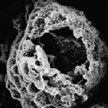 Graphene and graphene-based materials have attracted great attention in energy storage applications for batteries and supercapacitors owing to their unique properties of high mechanical flexibility, large surface area, chemical stability, superior electric and thermal conductivities that render them great choices as alternative electrode materials for electrochemical energy storage systems. A recent review article summarizes the progress in graphene and graphene-based materials for four energy storage systems, i.e., lithium-ion batteries, supercapacitors, lithium-sulfur batteries and lithium-air batteries.
Graphene and graphene-based materials have attracted great attention in energy storage applications for batteries and supercapacitors owing to their unique properties of high mechanical flexibility, large surface area, chemical stability, superior electric and thermal conductivities that render them great choices as alternative electrode materials for electrochemical energy storage systems. A recent review article summarizes the progress in graphene and graphene-based materials for four energy storage systems, i.e., lithium-ion batteries, supercapacitors, lithium-sulfur batteries and lithium-air batteries.
Oct 9th, 2014
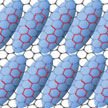 Ferroelectric liquid crystal (FLC) display technology holds the promise of fast switching times, a large viewing angle, and high resolution. FLCs have a spontaneous polarization whose direction is perpendicular to the layer. This spontaneous polarization plays an imperative role in the electro-optic switching of FLCs. Researchers have now developed a technique to amplify the spontaneous polarization by doping graphene into FLCs.
Ferroelectric liquid crystal (FLC) display technology holds the promise of fast switching times, a large viewing angle, and high resolution. FLCs have a spontaneous polarization whose direction is perpendicular to the layer. This spontaneous polarization plays an imperative role in the electro-optic switching of FLCs. Researchers have now developed a technique to amplify the spontaneous polarization by doping graphene into FLCs.
Sep 18th, 2014
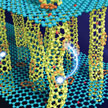 Researchers consider the rational combination of carbon nanotubes (CNTs) and graphene into three-dimensional hybrids an effective route to amplify the inherent physical properties at the macroscale. By in situ nitrogen doping and structural hybridization of carbon nanotubes and graphene, researchers have now successfully fabricated nitrogen-doped aligned carbon nanotube/graphene sandwiches. In this work, aligned CNTs and graphene layers were anchored to each other, constructing a sandwich-like hierarchical architecture with efficient 3D electron transfer pathways and ion diffusion channels.
Researchers consider the rational combination of carbon nanotubes (CNTs) and graphene into three-dimensional hybrids an effective route to amplify the inherent physical properties at the macroscale. By in situ nitrogen doping and structural hybridization of carbon nanotubes and graphene, researchers have now successfully fabricated nitrogen-doped aligned carbon nanotube/graphene sandwiches. In this work, aligned CNTs and graphene layers were anchored to each other, constructing a sandwich-like hierarchical architecture with efficient 3D electron transfer pathways and ion diffusion channels.
Sep 12th, 2014
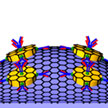 As a prime example of how the integration of multiple disparate nanotechnology fields allows the realization of novel or expanded functionalities, researchers have demonstrated a multimodal sensing device which integrates the functionalities of three traditional single mode sensors. Specifically, the team fabricated a graphene-based multimodal biosensing device, capable of transducing protein binding events into optical, electrical, and mechanical signals.
As a prime example of how the integration of multiple disparate nanotechnology fields allows the realization of novel or expanded functionalities, researchers have demonstrated a multimodal sensing device which integrates the functionalities of three traditional single mode sensors. Specifically, the team fabricated a graphene-based multimodal biosensing device, capable of transducing protein binding events into optical, electrical, and mechanical signals.
Sep 8th, 2014
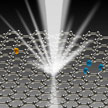 Researchers have demonstrated the experimental realization of the first all-carbon optical diode that is ready for scalable integration along with being inherently broadband in operation with no restrictions on polarization or phase-matching criteria. As they show, harnessing the optical properties of graphene-based materials offers an opportunity to create the all-photonic analogs of diodes, transistors, and photonic logic gates that will one day enable construction of the first all-photonic computer.
Researchers have demonstrated the experimental realization of the first all-carbon optical diode that is ready for scalable integration along with being inherently broadband in operation with no restrictions on polarization or phase-matching criteria. As they show, harnessing the optical properties of graphene-based materials offers an opportunity to create the all-photonic analogs of diodes, transistors, and photonic logic gates that will one day enable construction of the first all-photonic computer.
Sep 1st, 2014
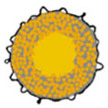 A three-dimensional crumpled graphene-encapsulated nickel sulfide electrode is reported as a superior high-energy lithium storage material. Compared with an electrode without crumpled graphene encapsulation, the optimized electrode yields significant improvements, especially in the cycling stability and rate capability. This enhanced performance is attributed to the 3D framework providing high continuous electron pathway and more free space for charge and mass transfer, and the stabilizing effect of the crumpled graphene based stretchy shell.
A three-dimensional crumpled graphene-encapsulated nickel sulfide electrode is reported as a superior high-energy lithium storage material. Compared with an electrode without crumpled graphene encapsulation, the optimized electrode yields significant improvements, especially in the cycling stability and rate capability. This enhanced performance is attributed to the 3D framework providing high continuous electron pathway and more free space for charge and mass transfer, and the stabilizing effect of the crumpled graphene based stretchy shell.
Aug 6th, 2014
 Ever since its discovery in 2004, graphene has been considered a relatively stable, high surface area platform to anchor nanostructured catalyst materials for various electrochemical and photocatalytic applications. The emergence of solution-based graphene in the form of graphene oxide has enabled new wet-chemistry approaches to the creation of graphene-based nanocomposites. A new study raises questions about the long-term stability of reduced graphene oxide in an aqueous environment where hydroxyl radicals can be present as part of the photocatalytic reaction cycle.
Ever since its discovery in 2004, graphene has been considered a relatively stable, high surface area platform to anchor nanostructured catalyst materials for various electrochemical and photocatalytic applications. The emergence of solution-based graphene in the form of graphene oxide has enabled new wet-chemistry approaches to the creation of graphene-based nanocomposites. A new study raises questions about the long-term stability of reduced graphene oxide in an aqueous environment where hydroxyl radicals can be present as part of the photocatalytic reaction cycle.
Jul 28th, 2014
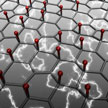 Transparent conductive coatings pervade modern technology. They are a critical component of optoelectronic devices such as smartphone and tablet displays as well as solar cells. The search for novel transparent electrode materials with good stability, high transparency and excellent conductivity is driven by the required trade-off between transparency and conductivity. In new work, researchers now have simultaneously increased the conductivity and transparency of ultra thin graphite by lithium intercalation.
Transparent conductive coatings pervade modern technology. They are a critical component of optoelectronic devices such as smartphone and tablet displays as well as solar cells. The search for novel transparent electrode materials with good stability, high transparency and excellent conductivity is driven by the required trade-off between transparency and conductivity. In new work, researchers now have simultaneously increased the conductivity and transparency of ultra thin graphite by lithium intercalation.
Jul 24th, 2014
 Graphene and graphene-based materials have attracted great attention in energy storage applications for batteries and supercapacitors owing to their unique properties of high mechanical flexibility, large surface area, chemical stability, superior electric and thermal conductivities that render them great choices as alternative electrode materials for electrochemical energy storage systems. A recent review article summarizes the progress in graphene and graphene-based materials for four energy storage systems, i.e., lithium-ion batteries, supercapacitors, lithium-sulfur batteries and lithium-air batteries.
Graphene and graphene-based materials have attracted great attention in energy storage applications for batteries and supercapacitors owing to their unique properties of high mechanical flexibility, large surface area, chemical stability, superior electric and thermal conductivities that render them great choices as alternative electrode materials for electrochemical energy storage systems. A recent review article summarizes the progress in graphene and graphene-based materials for four energy storage systems, i.e., lithium-ion batteries, supercapacitors, lithium-sulfur batteries and lithium-air batteries.
 Subscribe to our Nanotechnology Spotlight feed
Subscribe to our Nanotechnology Spotlight feed





